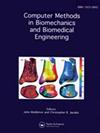基于梯度多孔tpms的颈椎融合器生物力学分析及优化:有限元研究。
IF 1.6
4区 医学
Q3 COMPUTER SCIENCE, INTERDISCIPLINARY APPLICATIONS
Computer Methods in Biomechanics and Biomedical Engineering
Pub Date : 2025-08-28
DOI:10.1080/10255842.2025.2551844
引用次数: 0
摘要
前路颈椎椎间盘切除术和融合术(ACDF)经常遭受椎笼下沉,影响对齐并引起术后疼痛。为了解决这个问题,我们提出了一种基于三周期最小表面(TPMS)结构和变密度拓扑优化的梯度多孔钛合金熔合笼。采用Gyroid微结构,在ACDF C4-C5模型中对设计进行了评估。与固体笼相比,优化设计将C5上表面的最大接触应力降低了25.6%,将正常应变提高了19.2%,降低了沉降风险并保持了生物力学稳定性。本文章由计算机程序翻译,如有差异,请以英文原文为准。
Biomechanical analysis and optimization of gradient porous TPMS-based cervical fusion cage: a finite element study.
Anterior Cervical Discectomy and Fusion (ACDF) often suffers from cage subsidence, compromising alignment and causing postoperative pain. To address this, we propose a gradient porous titanium alloy fusion cage based on Triply Periodic Minimal Surface (TPMS) structures and variable-density topology optimization. Using a Gyroid microstructure, the design was evaluated in an ACDF C4-C5 model. Compared with solid cages, the optimized design reduced maximum contact stress on the C5 superior surface by 25.6% and improved normal strain by up to 19.2%, demonstrating reduced subsidence risk and preserved biomechanical stability.
求助全文
通过发布文献求助,成功后即可免费获取论文全文。
去求助
来源期刊
CiteScore
4.10
自引率
6.20%
发文量
179
审稿时长
4-8 weeks
期刊介绍:
The primary aims of Computer Methods in Biomechanics and Biomedical Engineering are to provide a means of communicating the advances being made in the areas of biomechanics and biomedical engineering and to stimulate interest in the continually emerging computer based technologies which are being applied in these multidisciplinary subjects. Computer Methods in Biomechanics and Biomedical Engineering will also provide a focus for the importance of integrating the disciplines of engineering with medical technology and clinical expertise. Such integration will have a major impact on health care in the future.

 求助内容:
求助内容: 应助结果提醒方式:
应助结果提醒方式:


